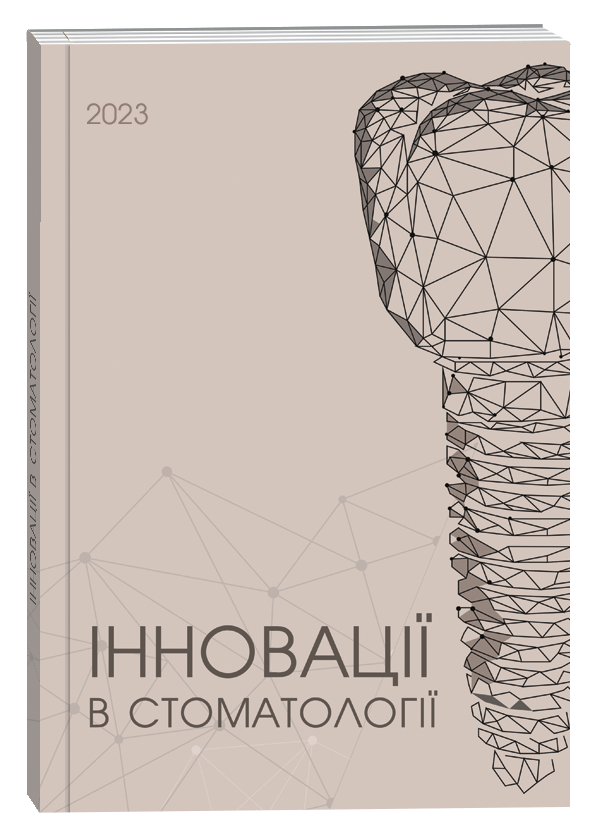SIGNIFICANCE OF PRELIMINARY ENDODONTIC CASE DIFFICULTY ASSESSMENT AS AN APPROACH FOR POTENTIAL PROGNOSTIC DIFFERENTIATION OF COMPLICATIONS PREVALENCE
DOI:
https://doi.org/10.35220/2523-420X/2025.2.9Keywords:
root canal treatment, endodontics, tooth, complications, complication, assessment criteria, prognosisAbstract
Purpose of the study. To verify the feasibility of using specific criteria for preliminary assessment of the endodontic treatment case complexity and to establish differences in the complications prevalence among different categories of the studied criterion. Research methods. The clinical phase was organized as a prospective study, in the structure of which dentists provided a subjective assessment of the complexity of the clinical case before endodontic treatment without using any specific-oriented criteria. The retrospective phase of the study involved randomization of anonymized radiographs of clinical cases obtained before and after the intervention, while maintaining their affiliation with each specific doctor, with the assessment of such according to standardized specific criteria according to the AAE Case Difficulty Assessment Standards, and noting the data obtained for each case. The comparative-analytical stage of the study was conducted by an independent expert, who compared the differences in the assessments of the complexity of endodontic treatment noted by dentists without and with the use of specific criteria, as well as assessed the prevalence of radiologically verified complications and obturation defects. Scientific novelty. The distribution of complications in cases of mild, moderate and high complexity of endodontic treatment was characterized by a statistically confirmed pattern of changes when reassessment of clinical cases using specific criteria was provided in comparison to situation of the initial classification of clinical cases based only on the subjective judgments of dentists (p < 0,05). Compared with the distribution of cases of different treatment complexity based on the subjective assessment of dentists, the prevalence of complications and obturation defects after reassessment according to specific criteria remained the same only for cases with mild treatment complexity (p > 0,05), but was statistically lower for cases with moderate treatment complexity (p < 0,05) and statistically higher for cases with high treatment complexity (p < 0.05). The correlation level of changes in the frequency of registered complications with increasing complexity of endodontic treatment, when latter was verified on the basis of the initial subjective assessments of dentists, was r=-0,43, while after reassessment of the complexity of treatment taking into account specific criteria, this indicator was r=0,83. Conclusions. The complexity of endodontic treatment, objectified by the use of specific criteria, is characterized by a higher level of correlation with the frequency of complications and obturation defects in clinical cases that met the parameters of moderate and high complexity, while the results of the subjective assessment of the complexity of root canal treatment demonstrated the presence of interdependencies with the frequency of complications only in cases categorized as high complexity. The initial assessment of the potential complexity of endodontic treatment does not allow to directly influence the risk of complications during the intervention, however, it allows to identify cases that are characterized by a higher probability of complications, and therefore require more attention during planning, as well as potential adaptation of the used therapeutic approaches, techniques and manipulations to the conditions of the clinical situation, which in turn will allow to reduce the risk of associated complications.
References
Gulabivala K., Ng Y. L. Factors that affect the outcomes of root canal treatment and retreatment–A reframing of the principles. International Endodontic Journal. 2023. Vol. 56. P. 82–115. URL: https://doi.org/10.1111/iej.13897
Alsinaidi Y. A., Almotairi T. A. T., Alyami I. M. [et al.]. Factors affecting root canal treatment outcomes: A systematic review. Saudi Journal of Oral and Dental Research. 2022. Vol. 7(11). P. 270–275. URL: https://doi.org/10.36348/sjodr.2022.v07i11.001
Baseri M., Radmand F., Milani A. S. [et al.]. The effect of periapical lesion size on the success rate of different endodontic treatments: A systematic review and meta-analysis. Evidence-Based Dentistry. 2023. Vol. 24(1). P. 43. URL: https://doi.org/10.1038/s41432-023-00851-1
Jawad S., Taylor C., Roudsari R. V. [et al.]. Modern endodontic planning part 1: Assessing complexity and predicting success. Dental Update. 2015. Vol. 42(7). P. 599–611. URL: https://doi.org/10.12968/denu.2015.42.7.599
Chandra A. Discuss the factors that affect the outcome of endodontic treatment. Australian Endodontic Journal. 2009. Vol. 35(2). P. 98–107. URL: https://doi.org/10.1111/j.1747-4477.2009.00199.x
Huang D., Wang X., Liang J. [et al.]. Expert consensus on difficulty assessment of endodontic therapy. International Journal of Oral Science. 2024. Vol. 16(1). P. 22. URL: https://doi.org/10.1038/s41368-024-00285-0
Shah P. K., Chong B. S. A web-based endodontic case difficulty assessment tool. Clinical Oral Investigations. 2018. Vol. 22(6). P. 2381–2388. URL: https://doi.org/10.1007/s00784-018-2341-1
Shah P. K., Duncan H. F., Abdullah D. [et al.]. Comparison of two case difficulty assessment methods on cohorts of undergraduate dental students – a multi-centre study. International Endodontic Journal. 2020. Vol. 53(11). P. 1569–1580. URL: https://doi.org/10.1111/iej.13377
Shah P. K., Zhang Q., Chong B. S. Get Smart – Technological innovations in endodontics part 2: Case-difficulty assessment and future perspectives. Dental Update. 2021. Vol. 48(7). P. 556–562. URL: https://doi.org/10.12968/denu.2021.48.7.556
Almohaimede A. A., AlShehri B. M., Alaiban A. A., AlDakhil R. A. Significance of endodontic case difficulty assessment: A retrospective study. International Dental Journal. 2022. Vol. 72(5). P. 648–653. URL: https://doi.org/10.1016/j.identj.2022.01.001
Fezai H., Al-Salehi S. The relationship between endodontic case complexity and treatment outcomes. Journal of Dentistry. 2019. Vol. 85. P. 88–92. URL: https://doi.org/10.1016/j.jdent.2019.05.019
Pesonen R., Tanner T., Käkilehto T. [et al.]. Usefulness of an endodontic case difficulty assessment form of root canal treatments in dental education in Finland. Dentistry Journal. 2021. Vol. 9(10). P. 118. URL: https://doi.org/10.3390/dj9100118
Long R., Dutta A., Thomas M. B., Vianna M. E. Case complexity of root canal treatments accepted for training in a secondary care setting assessed by three complexity grading systems: A service evaluation. International Endodontic Journal. 2022. Vol. 55(11). P. 1190–1201. URL: https://doi.org/10.1111/iej.13815
Mallishery S., Chhatpar P., Banga K. S. [et al.]. The precision of case difficulty and referral decisions: An innovative automated approach. Clinical Oral Investigations. 2020. Vol. 24(6). P. 1909–1915. URL: https://doi.org/10.1007/s00784-019-03050-4
Essam O., Umerji S., Blundell K. Endodontic assessment, complexity, diagnosis and treatment planning. British Dental Journal. 2025. Vol. 238(7). P. 441–447. URL: https://doi.org/10.1038/s41415-025-8452-6
Mumcu A. K., Çorak M., Kurnaz S., Kiraz G. Effect of case difficulty on endodontic mishaps: Preliminary findings. International Dental Journal. 2024. Vol. 74. P. S101. URL: https://doi.org/10.1016/j.identj.2024.07.880
Alamoudi R. A., Alharbi A. H., Farie G. A., Fahim O. The value of assessing case difficulty and its effect on endodontic iatrogenic errors: A retrospective cross-sectional study. The Libyan Journal of Medicine. 2020. Vol. 15(1). P. 1688916. URL: https://doi.org/10.1080/19932820.2019.1688916
Ree M. H., Timmerman M. F., Wesselink P. R. An evaluation of the usefulness of two endodontic case assessment forms by general dentists. International Endodontic Journal. 2003. Vol. 36(8). P. 545–555. URL: https://doi.org/10.1046/j.1365-2591.2003.00688.x
Goncharuk-Khomyn M., Noenko I., Cavalcanti A. L. [et al.]. Artificial intelligence in endodontics: Relevant trends and practical perspectives. Ukrainian Dental Journal. 2023. Vol. 2(1). P. 96–101. URL: https://doi.org/10.56569/UDJ.2.1.2023.96-101
Herbst S. R., Herbst C. S., Schwendicke F. Preoperative risk assessment does not allow to predict root filling length using machine learning: A longitudinal study. Journal of Dentistry. 2023. Vol. 128. P. 104378. URL: https://doi.org/10.1016/j.jdent.2022.104378
Qu Y., Wen Y., Chen M. [et al.]. Predicting case difficulty in endodontic microsurgery using machine learning algorithms. Journal of Dentistry. 2023. Vol. 133. P. 104522. URL: https://doi.org/10.1016/j.jdent.2023.104522
Chung S. H., Chang J. Impact of endodontic case difficulty on operating time of single visit nonsurgical endodontic treatment under general anesthesia. BMC Oral Health. 2021. Vol. 21(1). P. 231. URL: https://doi.org/10.1186/s12903-021-01586-0








